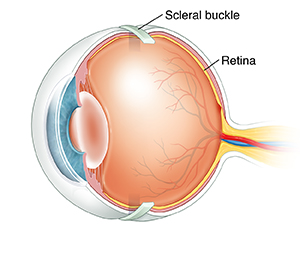Understanding Scleral Buckling Surgery
Understanding Scleral Buckling Surgery

What is a detached retina?
The retina is a layer of cells at the back of your eye. These cells use light to send visual information to your brain. Retinal detachment happens when part of your retina pulls away from the inner wall of your eye. When that happens, your retina does not work normally. Vision is lost in all or part of your retina. If not treated right away, this can cause permanent loss of eyesight.
Certain things make it more likely that you will have a retinal detachment. These include:
Nearsightedness
Other eye disorders, like uveitis
Past cataract surgery
Older age
Diabetes
Certain inflammatory disorders, like rheumatoid arthritis
Most of the time a detached retina happens on its own with no cause. But sometimes injury to the eye can cause it.
Why scleral buckling surgery is done
A detached retina can cause loss of eyesight. You may have an increase of floaters in your eye. These look like little specks or cobwebs that float in your field of vision. These floaters can be so dense that they affect your eyesight. You might also have light flashes in your eye or a curtain over your field of vision. If you have these symptoms, you may need an emergency surgery to reattach the retina. This can restore eyesight.
How scleral buckling surgery is done
The surgeon will make a cut (incision) in the outer layer of your eye. He or she will use an ophthalmoscope to view your retina. A device will be used to seal the layers of your retina back together. In most cases, the device uses extreme cold to do this. A very small band or buckle is placed around the outside of your eyeball. This helps make sure that your retina stays in place.
Risks of scleral buckling surgery
All surgery has some risks. The risks of this surgery include:
A scar on or under the retina (proliferative vitreoretinopathy)
Detachment of the eye layer beneath the retina
Bleeding (hemorrhage) in the eye
Retina folds and is pulled back into the retinal break or tear (retinal incarceration)
Infection
Nearsightedness that gets worse
Cataracts
Increased pressure in the eye
Double vision
New retinal tears
Return of a retinal tear
Need for another surgery
Updated:
June 23, 2017
Reviewed By:
Finke, Amy, RN, BSN,Haupert, Christopher L., MD,Image reviewed by StayWell medical illustration team.